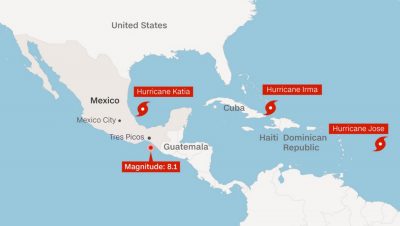When three major hurricanes and just as many powerful earthquakes happen at around the same time, as they did in 2017, many wonder if they are connected.

Source: National Hurricane Center
*Hurricane locations as of September 8, 2017, 2 a.m. EDT
While the 2017 hurricanes and the earthquakes in Mexico are likely not connected, geophysicist Shimon Wdowinski believes there could be a correlation between hurricanes and the earthquakes that come much later. He is spearheading research supported by NASA examining whether powerful hurricanes can trigger earthquakes.
Wdowinski developed the idea for the research project following the 2010 earthquake in Haiti. The magnitude 7 event destroyed much of Por-au-Prince and killed upwards of 300,000 people. Two years prior, four powerful hurricanes — Fay, Gustav, Hanna and Ike — dumped heavy rains on Haiti in just a matter of weeks, killing 800 people and devastating crops.
In certain mountainous environments prone to both tropical cyclones and earthquakes, heavy rain — 3 to 9 feet of rain in a span of 3 to 5 days — can induce a large number of landslides. Over time, the landslide material is carried to the ocean resulting in significant erosion of the mountains and affecting the stress field within the Earth’s crust. Wdowinski thinks this could trigger an earthquake. If he is right, an earthquake can occur several months to years after a wet cyclone strikes in an area.
Haiti experiences limited seismic activity so Wdowinski is testing his hypothesis in Taiwan, where there is plenty of earthquake and cyclone data to examine.
“We plan to provide convincing observations that will demonstrate the proposed cascading relations between wet tropical cyclones, landslides and earthquakes,” Wdowinski said.
He believes whatever results he gets will be applicable to the Caribbean and parts of South America. The data can also be applied to other similar tectonic environments affected by wet tropical cyclones including the Philippines where a magnitude 6.5 earthquake hit in July of 2017 — the same region devastated by Typhoon Haiyan in 2013.
Although the delay of months and years between wet cyclones and earthquakes will make it difficult to translate results into a forecasting tool, Wdowinski hopes the data can be used to issue a general warning about possible future earthquakes.






